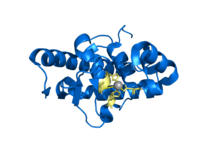Lys-N
Lys-N is a metalloendopeptidase found in the mushroom Grifola frondosa that cleaves proteins on the amino side of lysine residues.[1]

Crystal structure of Lys-N with co-ordinated zinc atom.[2]
Mass spectrometry
Lys-N is becoming a popular protease used for protein digestion in proteomics experiments. The combination Lys-N proteolytic peptides and mass spectrometry sequencing with ETD creates tandem mass spectra composed mostly of amino terminal peptide fragment ions.[3] This fragmentation pattern facilitates the applicability of these spectra for de novo peptide sequencing.[3]
gollark: This is apparently not the case in their graph, though.
gollark: https://www.science20.com/content/information_density_all_languages_communicate_at_the_same_rate
gollark: Oh dear. The first search result I looked at says that all languages operate at the same rate.
gollark: Maybe this is some deep underlying feature of language™ or maybe it's just a quirk of the 8 languages they picked.
gollark: The information rate is weirdly consistent given that information density and syllable throughput vary quite a lot.
References
- Nonaka T, Hashimoto Y, Takio K (July 1998). "Kinetic characterization of lysine-specific metalloendopeptidases from Grifola frondosa and Pleurotus ostreatus fruiting bodies". Journal of Biochemistry. 124 (1): 157–62. doi:10.1093/oxfordjournals.jbchem.a022074. PMID 9644258.
- RCSB Protein Data Bank - RCSB PDB - 1G12 Structure Summary
- Taouatas N, Drugan MM, Heck AJ, Mohammed S (May 2008). "Straightforward ladder sequencing of peptides using a Lys-N metalloendopeptidase". Nature Methods. 5 (5): 405–7. doi:10.1038/nmeth.1204. PMID 18425140.
External links
- The MEROPS online database for peptidases and their inhibitors: M35.004
- Coverage on Genomeweb
- Enzyme entry at SWISS-PROT
This article is issued from Wikipedia. The text is licensed under Creative Commons - Attribution - Sharealike. Additional terms may apply for the media files.